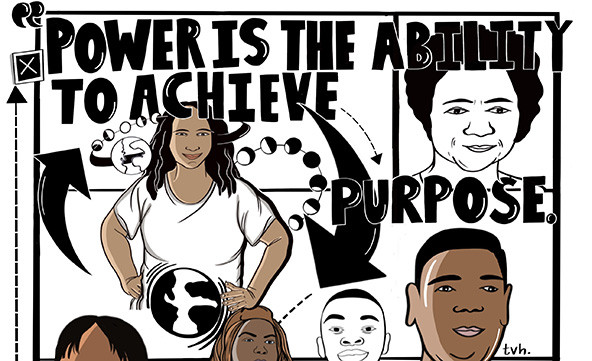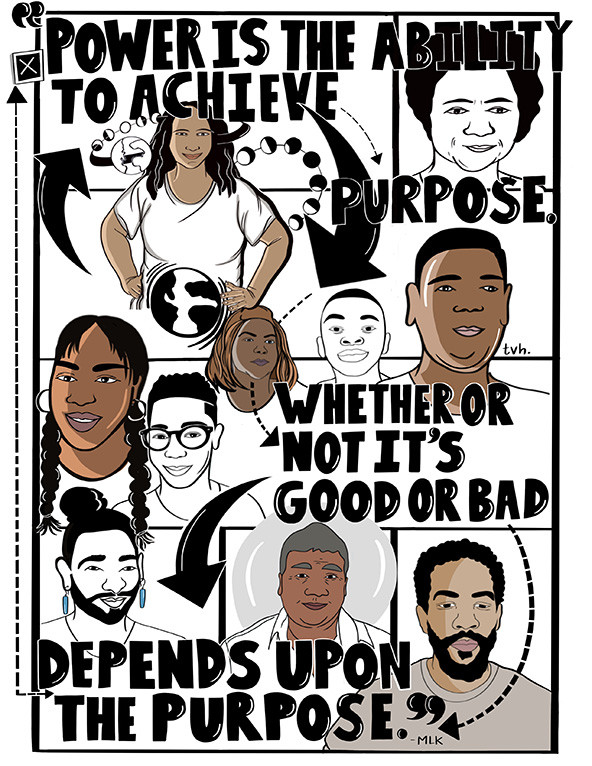 (Illustration by Taslim van Hattum)
(Illustration by Taslim van Hattum)
Over the last few decades, philanthropy and other sectors of the progressive movement have made an enormous leap forward in setting dramatically more ambitious goals. It was not so long ago that few foundations or community organizations would have been focused on eradicating structural racism and narrowing economic inequality, but today, those and similar goals animate broad swathes of the movement (however long-term the aspiration may be).
Having struggled with these goals for six decades, I have come to understand that the most pressing question has to do with strategy: How to get from here to there? A three-year plan might suffice for more modest objectives, but what is needed to achieve the transformational goals we have for addressing poverty, racism, and inequity?

The term “strategy” has a multiplicity of meanings and a considerable literature. Movement leaders have much to learn from strategic thinkers in other fields. In this article, I want to consider the ways in which military strategy can provide guidance for the task ahead.
Why military strategy?
For one thing, a key aspect of military strategy is engagement with an enemy, an extreme oppositional force. This is important: Structural racism and economic inequality are not only deeply embedded in our society, but powerful, system-level political, economic, and social institutions work to keep it that way. Because of this active and powerful opposition to change, the challenge of achieving a complex, system-level goal in the face of powerful opposition is uniquely well served by military strategy, rather than business or campaign strategies.
For example, power analysis—of the opposition, our forces, and the overall context—is an integral part of military strategic thinking, yet macro and ecosystem-level power analysis is often absent in the organizational strategizing and planning of progressive philanthropy and allies. But without an analysis of conservative power, progressives are left with overly optimistic assumptions (or, worse, they implicitly ignore the opposition and operate with willful ignorance of the full terrain).
Military Strategy in a Nutshell
A schematic definition of military strategy has three essential components: ways, means, and ends (ways is the military term for the “how” of strategy, ends are the goals, and means are the forces or resources necessary to accomplish them). To translate these components into a more familiar example, we might say that The California Endowment’s (TCE’s) Building Healthy Communities initiative used its funds and its staff (the means) to build the capacity of communities (the ways) to work towards health equity and the dismantling of structural racism (the ends).
TCE’s strategy is an excellent stand-in for the aspirational goals of many progressive organizations. However, the problem remains that for “ways,” there is no simple or satisfactory approach to solving complex “wicked problems” and achieving complex goals of systems transformation, and, until recently, not even much serious discussion about the “means.” However, over the past few years, a few organizations have explored a promising concept that can help fill these gaps: governing power.
Using government as a tool to multiply progressive power is central to the strategy, out of the necessity to face up to the extraordinary power of our opposition. Government can act as a lever that multiplies our power, and we must utilize the various branches, institutions, and legal bases of government to achieve our ends. Examples of such levers include the 13th, 14th, 15th, and 19th Amendments, the Sherman Anti-Trust Act, the Wagner Act, the Civil Rights Act, and the Voting Rights Act. However, the lever of government doesn't act on its own; progressive power has to be applied with enough force to overcome the conservative forces that have dominated government for most of our history.
Power and Power Building
For our collective use, we should define “power.” For the military, the meaning is self-evident: the capacity to achieve its goals. Martin Luther King, Jr. used a similar definition, but with an important addition: “Power is the ability to achieve a purpose. Whether or not it is good or bad depends upon the purpose.” For our use, then, purpose is part of power. The military wants the capability to win wars, and while I have never heard the phrase “power building” used in a military context, the military recruits, builds weapons, pays for military personnel, trains leaders, and so on, in order to maintain or increase the ability to win wars.
In our context, power building is for community organizations, who are not ordinarily thought of as fighting wars, even metaphorical. And yet community organizers work with real communities to “fight” against an immediate and pressing problem in their community. Some of these battles have been lost, but community organizers are realists who need to recruit and retain local folks; sensibly enough, one of the key criteria for choosing campaigns is that they are winnable. When a community organization picks a campaign, its leaders have made an estimate ahead of time that it is winnable.
Winning campaigns is excellent for the organizations and the people impacted by the victories, but such wins are also tactical. The military likes to win tactical battles too, of course. However, military strategy stresses the difference between winning battles and winning the war (it is, after all idiomatic that you can win all the battles but lose the war). And yet our focus on power building has often been about power for communities, which is to say, about tactical battles.
What about system transformation and structural change? What about winning the war?
Community Organizing Is Necessary But Not Sufficient
Organizing at the community level is necessary to achieve transformational goals, but more is needed. Community organizations are like platoons: no platoons, no wins at any level. But platoons can only fight in their immediate surroundings. The painful challenge for communities is that the problems they face are often not community problems, originating far beyond immediate surroundings: perhaps a company headquartered in London, through laws passed by the state legislature, or a water infrastructure neglected over decades that will require federal funds and intervention to replace. A power analysis of the opposition would reveal an interconnected set of institutions, laws, and outside forces, against which even a powerful and well-organized community cannot prevail.
 (Illustration by Taslim van Hattum)
(Illustration by Taslim van Hattum)
The military metaphor is not always apt, of course. To remedy a lead-poisoned water system, for example, it would be critical on tactical, moral, democratic, and indeed strategic grounds for an outside force to operate in close cooperation with the local community and with great respect for the community's expertise and the stakes and remedies as the community sees them. Military leadership might consult with a platoon about next steps, but the relationship is more one-sided. Other contradictions can emerge in applying the military analogy to social change strategy.
However, a military analysis allows us to see the task ahead of us in a new perspective. For example, a power analysis of the fight against structural racism suggests that while a community can fight manifestations of structural and institutional racism, the system-level forces and institutions that maintain structural racism and class and gender inequities require a different set of actions.
Whatever the limitations of comparing a community organization to a platoon, the comparison leads to an obvious question: What kind of power building do we need to transform the deep structures of our society and achieve governing power?
Political Infrastructure
A necessary part of answering this question is to look at the opposing “army,” by which I mean the formations that maintain oppressive and unequal conditions. There is extensive literature: Karen Paget’s 2001 “Lessons of Right-Wing Philanthropy,” for example, or Alex Hertel-Fernandez’s more recent book, State Capture. The opposition's army, what I will call its “political infrastructure,” is more than a collection or an ecosystem of organizations; it is an integrated, coordinated, and strategically oriented network of different kinds of social change groups. Think tanks, policy and research groups, training institutes, large grassroots organizations, and funders are integrated into this infrastructure.
Most critically, a political infrastructure has a strategic function: to win political, economic, and ideological power. But nothing in this definition specifies the political orientation of a political infrastructure. The conservative infrastructure is held together by shared values and ideology, overlapping and interconnected organizations, shared leadership training, and funding. But while there are, of course, serious differences among the sectors of the conservative infrastructure, they function together, primarily, because if they do, they will continue to hold on to political and economic power. And that is the power that is the barrier to our struggles for racial and gender justice, greater economic equality, and democracy.
In general, while the opposition’s army is a well-funded and robust political infrastructure, the progressive side’s forces are highly fragmented. We have many pieces of the puzzle: Thousands of communities are active in various fights, unions who weigh in on large-scale issues, think tanks, advocacy and communication shops, and organizing networks and institutions. But while deeper collaborations have emerged, more is needed to tie together these disparate parts of the progressive movement and to work out a division of labor that aims at real governing power.
To return to ways and means, the “ways” to achieve our goals is to use the government as a lever for transformational change; the "means" to get to governing power is to build a political infrastructure unified by the overarching goal of gaining political and economic power. In this schema, power is both a means and an end; at each stage, it is vital to build more power (as an end) and at the same time to ensure the power is used as a means to achieve racial and economic equity. The ways, the means, and the ends need to fit together.
Infrastructure Building
Collaborations in community organizing is happening: There is labor–community coordination and cooperation in some states, and many progressive organizations are working to overcome fragmentation. Collective impact is an instance of infrastructure power building. Certain states and cities have become laboratories for ways of building progressive infrastructure and moving toward governing power. Foundations are a vital part of infrastructure building at this level: Organizations need space, funding, and outside expertise to figure out functional divisions of labor that create something more than the sum of the parts. Organizations need resources to make the possibilities of political power real enough to incentivize more infrastructure building.
The operational implication of this argument is that we need to move from focusing primarily on community organizations—fundamental as they are—to larger-scale structures and progressive infrastructure building (in part, because doing so will lead to stronger community organizations). But we need to know much more about what it takes to build large-scale forms of political infrastructure. Sometimes efforts around collaboration are discussed in terms of an ecosystem composed of proximate organizations—platoons operating in the same region, as it were. However, creating powerful political infrastructure requires more than collaboration. It means creating a cohesive network that functions to achieve larger goals around equity and governing power.
To build the next stage of a progressive political infrastructure, we need to answer questions like these: How do networks of community organizations work with unions, local business groups, and the local and state Democratic Party? How do progressive organizing groups work with think tanks and with funders? Unfortunately, there are no pat answers, though examples of such work are emerging nationwide.
Conclusion
I began this article by noting the evolution of progressive organizations and philanthropy over the past 10 to 20 years regarding societal transformational and system-level changes. We should celebrate this evolution. It has been difficult to develop these more “radical” goals. That difficulty is also worth noting, as it is related to how hard it continues to be to acknowledge the opposition’s power and nature. It is painful to recognize the gap between current conditions in our society and those goals and to see that the gap is growing.
Strategy is the domain where these issues are dealt with. I have employed concepts from military strategy that I think are necessary for the changes we are fighting for. I look forward to others taking their favorite approaches to strategy and working with organizations to see how we start to make strategy real, tested, and operational.
Support SSIR’s coverage of cross-sector solutions to global challenges.
Help us further the reach of innovative ideas. Donate today.
Read more stories by Richard Healey.

